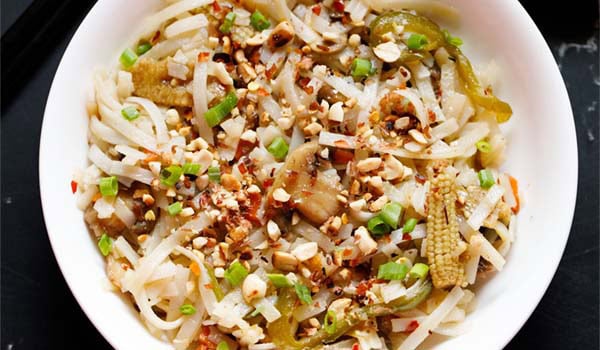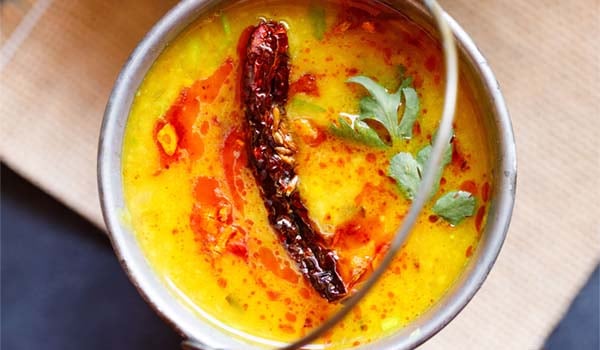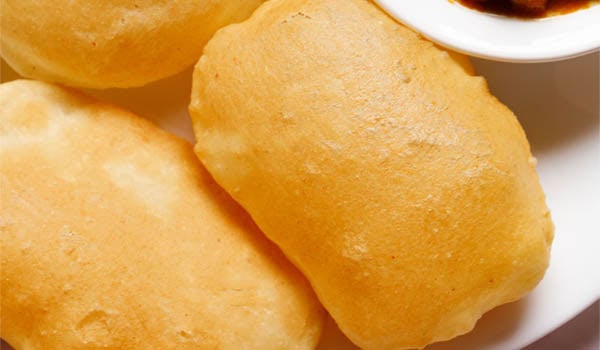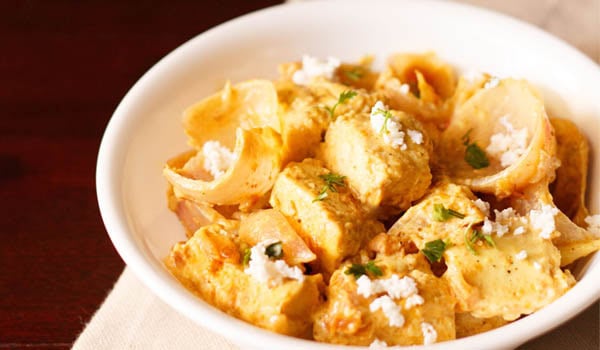This recipe presents a vegetarian, Thai-inspired version of Pad Thai—a quick and flavorful stir-fried rice noodle dish perfect for weeknight dinners. While it deviates from traditional recipes, it captures the sweet, tangy, and umami-rich flavors through ingredients like tamarind, palm sugar, soy sauce, mushrooms, and a variety of fresh vegetables. Free from fish sauce and eggs, this dish is ideal for both vegetarians and vegans, and can be easily customized with pantry staples.
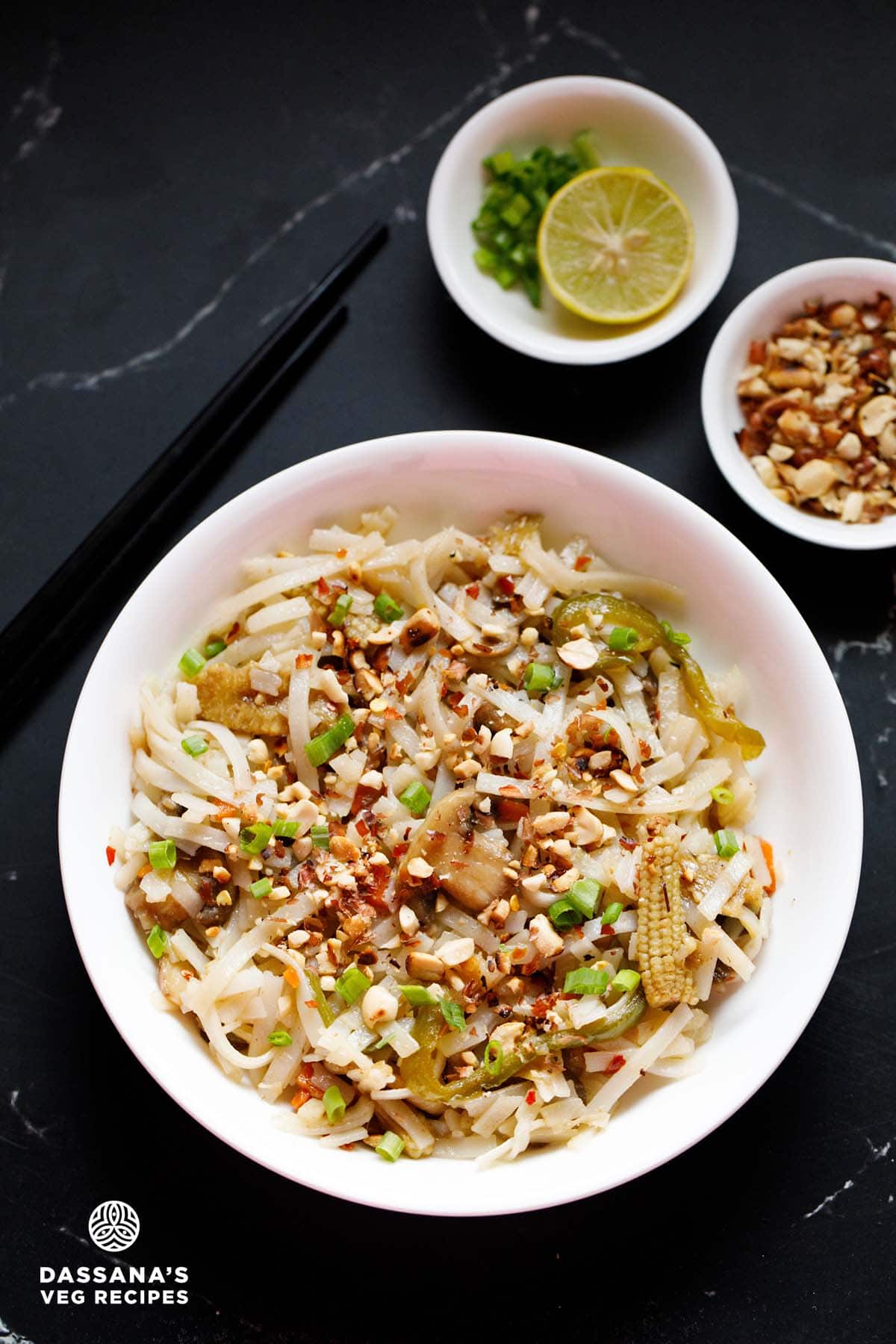
About Pad Thai
Pad Thai is a vibrant stir-fried noodle dish known for its bold flavors. Featuring rice noodles, crunchy vegetables, roasted peanuts, and a tangy tamarind-based sauce, it achieves a delightful balance of sweet, sour, and savory notes.
This easy, meat-free version is satisfying, wholesome, and can be tailored to include your favorite vegetables.
During our travels in Thailand, especially in cities like Bangkok and Chiang Mai, we were captivated by the simplicity and depth of flavor found in the vegetarian dishes served at local eateries and bustling street food stalls.
While Thailand’s street food scene is renowned for its diversity, vegetarian options were sometimes limited. However, we discovered a range of memorable favorites—from crispy Vegetable Spring Rolls to fragrant Green Curry, spicy Red Curry, and the ever-popular Pad Thai. Each dish offered a perfect blend of bold flavors, fresh ingredients, and that comforting Thai essence.
Pad Thai quickly became our go-to choice—a harmonious mix of sweet, sour, salty, and spicy flavors, paired with soft rice noodles, crunchy peanuts, and fresh vegetables. Served with lime wedges and extra peanuts, it always felt like a complete and satisfying meal.
What Makes This Pad Thai Unique
Inspired by our travels, I created a fully vegetarian and vegan version at home that can easily be made gluten-free with a few simple swaps.
This Pad Thai recipe features a mild, tangy-sweet profile, with lime juice and peanuts as essential garnishes.
While this isn’t a classic Pad Thai, it incorporates the same flavor elements—tanginess from tamarind, sweetness from palm sugar, savory depth from soy sauce, and crunch from roasted peanuts.
Why This Recipe Works
Since I cook vegetarian, I’ve omitted fish sauce and eggs, adding mushrooms for a rich umami profile. Occasionally, I include plant-based oyster mushroom powder for extra umami, but this is optional.
This version is adapted for easily accessible pantry ingredients, making it a comforting and satisfying one-bowl meal.
While rice noodles are traditional, any noodle variety can be used, and tofu makes a great protein-rich addition. I’ve skipped pickled radish here, as the vegetables provide ample texture and soak up the flavorful sauce beautifully.
This version lacks the darker brown hue typical of restaurant-style Pad Thai, as I’ve used freshly extracted tamarind water instead of commercially prepared tamarind concentrate or sauce, which tends to be more intensely colored.
Nonetheless, the dish delivers the authentic tangy-sweet flavor Pad Thai is known for. Adjust the flavors to suit your taste by varying the amount of tamarind water and sweeteners like palm sugar or brown sugar.
Crushed roasted peanuts and chopped spring onions are my go-to garnishes for this dish, adding both texture and freshness. Optionally, you can use coriander leaves (cilantro) as well.
It is crucial not to overcook the noodles—they should be tender yet firm, as overcooking can lead to stickiness or mushiness.
This homemade Pad Thai has become a staple in our kitchen—quick, nourishing, and bursting with vibrant flavors. It’s perfect for busy weeknights or as a weekend indulgence.
The recipe is naturally vegan and vegetarian, and can easily be made gluten-free by using gluten-free soy sauce or tamari.
How to Make Pad Thai
Make Tamarind Water
- Soak 1 tablespoon of tamarind in ⅓ to ½ cup of hot water for 20 to 30 minutes.
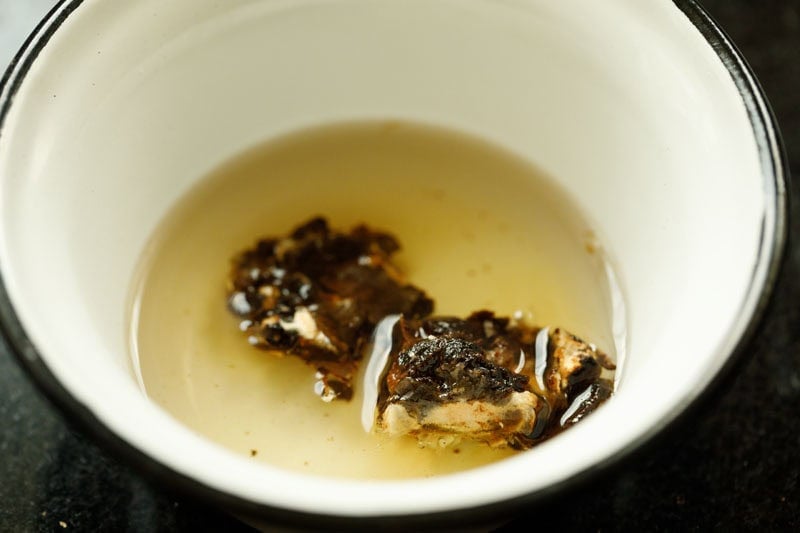
Once softened, squeeze and extract the pulp into the water. Discard the fibrous bits and set the tamarind water aside.
Note: If using store-bought tamarind paste, use about 1 to 1½ teaspoons and dissolve it directly into the sauce later.
Prep Rice Noodles, Veggies & Garnishes
- Cook 200 grams of flat rice noodles according to the package instructions until al dente.
- Depending on the brand, you may need to boil them for a few minutes or soak them in hot water for 25 to 30 minutes until tender yet firm. Drain well to prevent sticking.
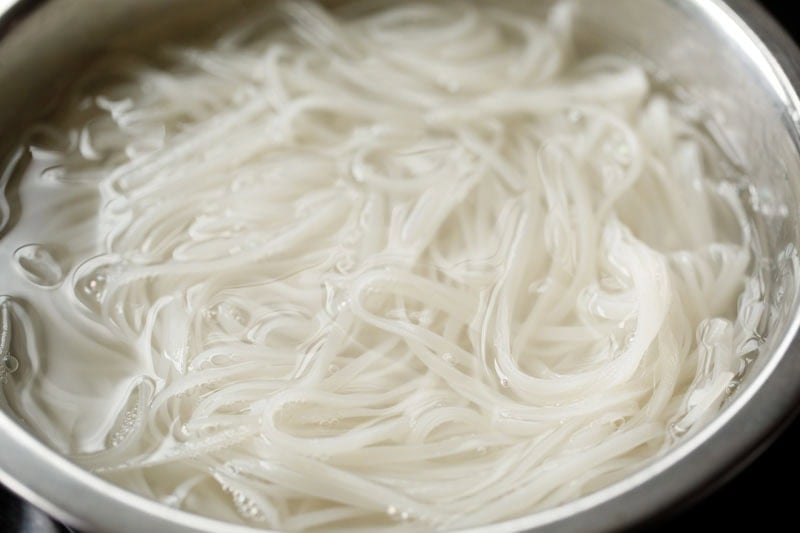
For this recipe, I used 4 cups of water to cook the noodles. Once cooked al dente, drain them using a strainer or colander and let them cool completely.
You can optionally rinse the cooked noodles again in water to stop the cooking process and help prevent clumping.
Rinse, chop, and prepare all the vegetables and mushrooms. Finely chop the garlic.
If using raw peanuts, toast or roast them in a skillet or oven until crunchy. Let them cool, then coarsely crush using a mortar and pestle or a food processor. Avoid grinding into a fine powder.
Sauté Aromatics, Mushrooms & Veggies
- In a heavy wok or pan, heat 3 tablespoons of oil on high heat. Add ½ cup of sliced spring onion whites and 2 teaspoons of finely chopped garlic. Stir-fry for 1 minute until aromatic.
- Add 3 cups of sliced mushrooms, ⅓ cup of finely chopped carrots, and ½ cup of sliced baby corn.
- Stir-fry until the mushrooms release their moisture and the mixture becomes fairly dry.
- Next, add 1 cup of sliced green bell pepper and stir-fry for 2 to 3 minutes on high heat.
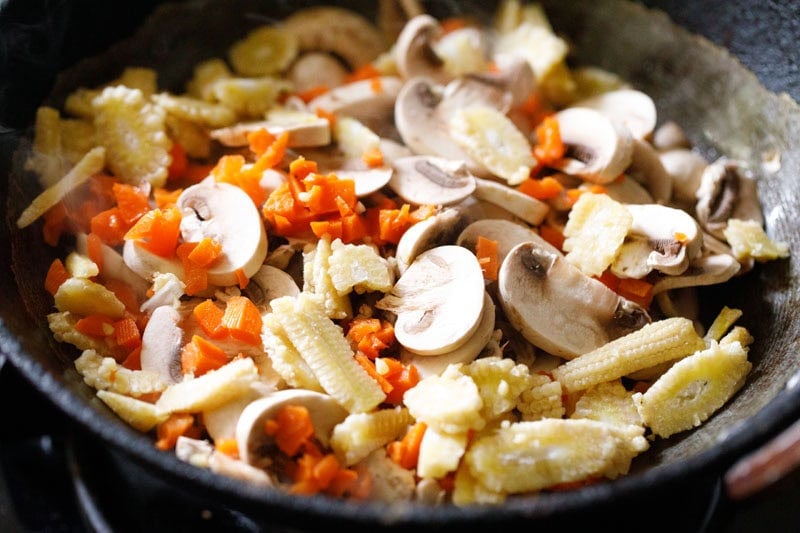
Make Sauce
- Add 1 teaspoon of red chili flakes and 1 teaspoon of oyster mushroom powder (optional).
- Pour in the prepared tamarind water, 2 tablespoons of dark soy sauce, 1 tablespoon of rice vinegar, ¼ cup of palm sugar, and salt to taste.
- Mix everything well and simmer on medium heat for 4 to 5 minutes or until the sauce thickens slightly.
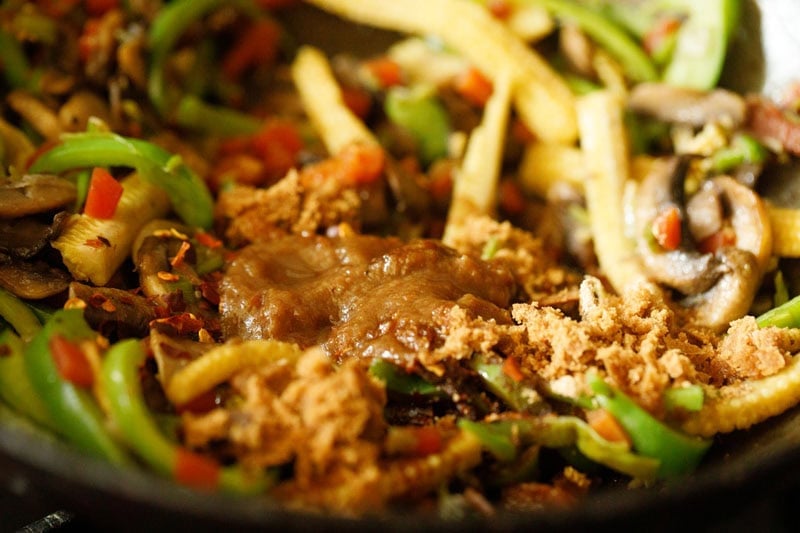
Make Pad Thai
- Add the cooked and cooled rice noodles. Gently mix until the noodles are evenly coated with the sauce.
- Taste and adjust the seasoning. You can add more soy sauce, tamarind, or sugar as per your preference.
- Serve portions of Pad Thai in plates or bowls. Garnish with ¼ to ⅓ cup of chopped spring onion greens (divided), ½ cup of coarsely crushed roasted peanuts (divided), and lime wedges. Optionally, garnish with coriander leaves (cilantro) for added freshness.
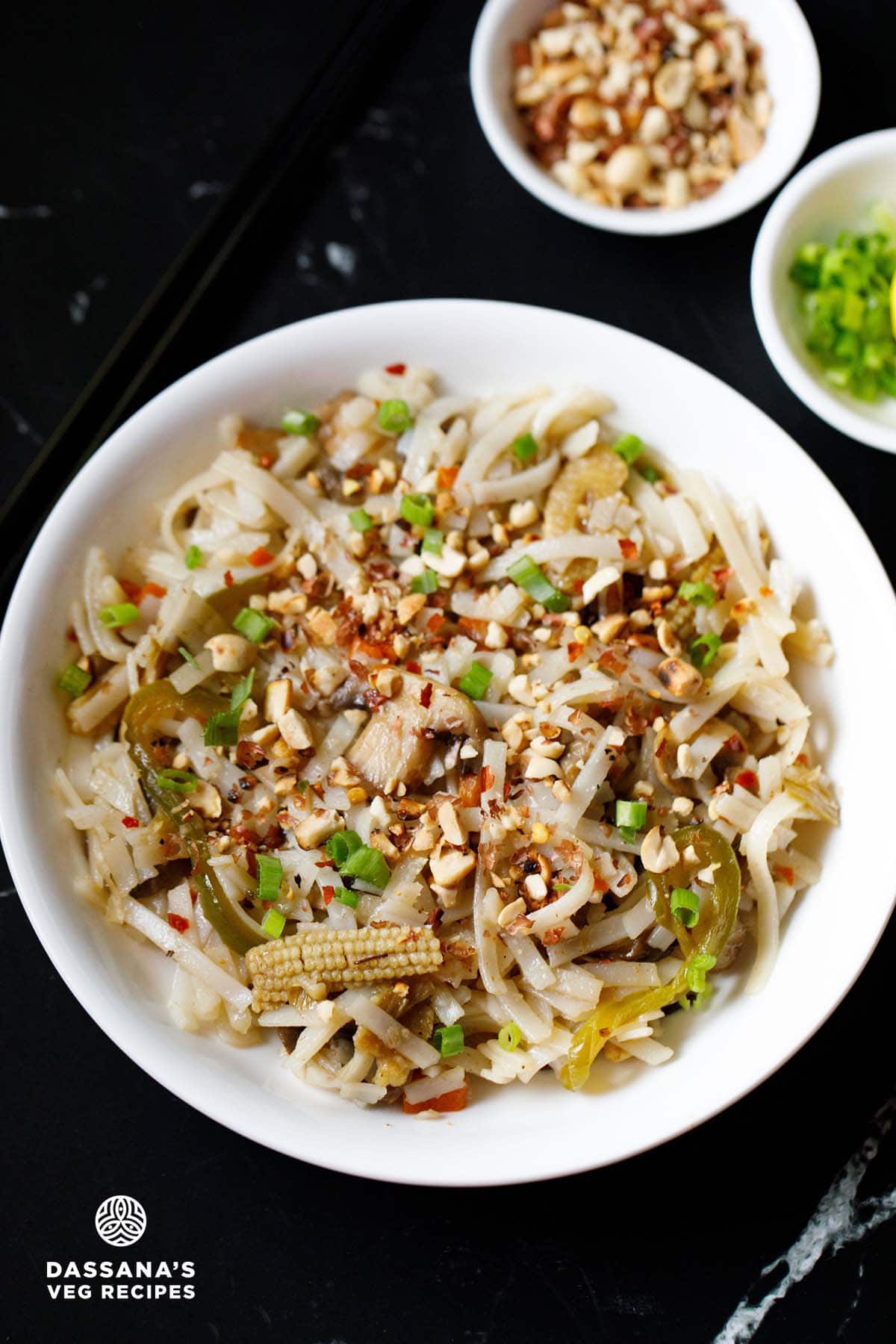
Serving & Storage Suggestions
Best enjoyed hot or warm. Serve as a main course for lunch or dinner, paired with a light soup or salad. Tom Kha Soup and Tom Yum Soup are lovely pairings.
You can also serve it with crispy Vegetable Spring Rolls or refreshing Thai Green Papaya Salad to create a complete Thai-style meal.
For dessert, consider something light and tropical like Thai Mango Pudding—a smooth, chilled dessert made with ripe mangoes and coconut milk.
While refrigeration isn’t ideal as it alters the taste and flavor, if you must store it, reheat by sprinkling a little water to prevent dryness, then gently sauté in a skillet or warm it up in a pan. If refrigerating, store in an airtight container and consume within a day for best results.
Expert Tips
- Rice noodles: Avoid overcooking—they should be tender with a slight chew (al dente).
- Cooling the noodles: Allow the noodles to cool completely before stir-frying to prevent them from becoming sticky or clumping together.
- Noodle alternatives: If flat rice noodles aren’t available, any similar flat noodle variety can be used as a substitute.
- Pickled radish: While traditional Pad Thai uses pickled daikon, this version skips it, relying on veggies and sauce for crunch and flavor. Feel free to include it if you have some.
- Must-have toppings: Don’t skip the crushed peanuts and a squeeze of lime juice—they really enhance the dish.
- Tofu & sprouts option: Add cubes of extra-firm tofu, pan-fried until golden, along with mung bean sprouts for extra texture and protein.
- Optional freshness: Garnish with chopped coriander (cilantro) for a burst of fresh, herbal flavor.
- Oil type: Use a neutral oil (like sunflower or avocado) for stir-frying to avoid overpowering the sauce flavor.
- Heat control: Use a heavy wok and stir-fry on medium-high to high heat for the best texture and quick caramelization. Regulate the heat as needed.
FAQs
Traditional Pad Thai uses thin flat rice noodles. Depending on the brand, you may need to either boil them briefly or soak them in warm water for about 30 minutes until they soften and become pliable enough for stir-frying.
To make it gluten-free, substitute the soy sauce with tamari or a gluten-free alternative. The rest of the ingredients are naturally gluten-free.
You can replace it with a combination of lime juice and a small amount of brown sugar, but keep in mind the flavor won’t be exactly the same.
Simply reduce the quantity of sugar or palm sugar in the sauce to suit your taste.
Absolutely! Add vegetables such as bell peppers, zucchini, carrots, snap peas, or even spinach. Just make sure they complement the sauce and don’t overpower the overall taste and flavor.
Make sure to cook the noodles to an al-dente texture. Additionally, cool the noodles after cooking and toss them with a few drops of oil. Avoid overcooking, and stir-fry on medium-high to high heat quickly.
Pad Thai is best enjoyed fresh, but you can prep the sauce and chopped vegetables in advance to save time. Combine and stir-fry everything just before serving.

